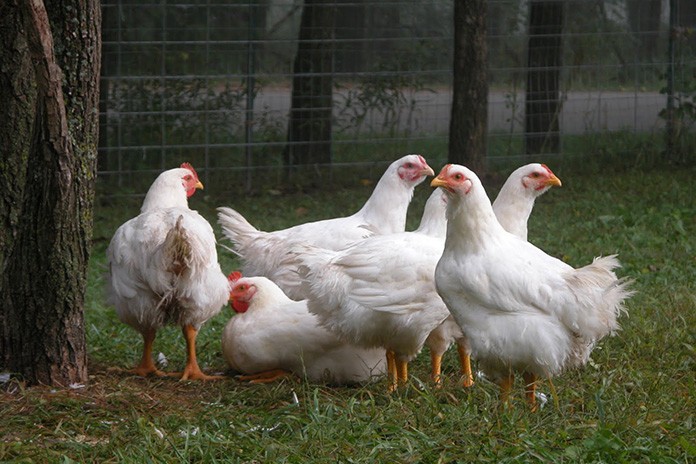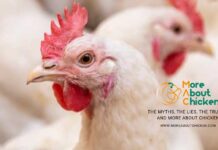
There is a lack of scientific knowledge relative to the use of the outdoor broilers and its implications, advantages or disadvantages, in terms of bird behaviour and welfare.
Therefore this study investigated behavioural time budgets of broiler chickens on two commercial farms. Behaviour was monitored inside the shed and in outdoor broilers areas, differing in resource availability (tree, shade cloth or no resource present) and distance from the shed (adjacent to the shed wall or 7.5m from the shed). Results indicated that distance is a deterrent for range use, as few broiler chickens were seen in areas 7.5m from the shed.
Furthermore, behavioural time budgets differed between broiler chickens observed in the shed compared to outdoor broilers in the range; there was more active, exploratory and vigilant behaviours seen in the range and more resting and comfort behaviours observed in the shed. However the implications of such behavioural differences remain unknown.
Measuring behavior is a useful tool to determine an animal’s metal wellbeing and thus welfare status.
Very few studies have investigated the differences in broiler behaviours in the outdoor range as compared to indoor, or between range areas. Comparing broiler behavior inside the shed and out in the range may indicate if range access permits or encourages particular behaviours. If these behaviours have proved important to broilers one may suggest their welfare state is improved with range use. It is likely that the effects of range use will differ depending on what part of the range an individual utilizes, again these effects may be reflected in their behavior, i.e. areas far from the shed with no cover or resources may elicit a fear response, evidence of this would include less resting and more vigilant behaviours. Indeed it has been suggested that free-range broiler behaviours are related to resource availability and ranging distance.
However the results of these studies may not reflect chicken behavior within an Australian commercial setting, primarily due to different climatic conditions but also differences in flock size, strain, growth rate, and experimental settings (i.e. non commercial properties). Such an understanding is likely to help range design and management to encourage a more uniform distribution of birds in the range and increase the welfare of the individuals that utilize the range by providing what they want.
We hypothesized that there are differences between the number and frequency of behaviours in the shed compared to outdoor broilers in the range, and between range areas that differed in distance from the shed and resource availability. Six 2.5 × 3 m areas were studied: in the shed at the centre or along an edge, outside along the shed with or without a shade cloth cover, and 7.5 m from the shed with or without a tree. Behaviour was recorded daily via video cameras from 21 to 40 days of age during range access, 08.00-17.00 h; every second day of video footage was analysed.
The behaviour of four randomly chosen birds was observed for 30 sec in each location every hour. In addition, the number of birds in each location was noted hourly for every day of range access. Data were analysed using GLM in Minitab if considered normal, to test the effects of inside vs. outside, resource (either tree or shade cloth) and distance, with time and age as repeated measures, or with a Kruskal-Wallis test otherwise.
Little data was collected from farm one with seven days of range access due to poor weather conditions (average minimum temperature 8.6 °C, average maximum temperature 12.7°C, total rainfall 89.3 mm), relative to farm two (average minimum temperature 10.2 °C, average maximum temperature 16.9°C, total rainfall 54.5 mm), which consequently had 28 days of range access.
On Farm two, there was an effect of distance (P<0.001) but not resource on the number of birds in the range, such that similar numbers of birds were found close to the shed with or without a resource, and very few birds 7.5 m from the shed with or without a resource. As expected weather conditions had an effect on the number of birds located in the range, however there was no effect of time of day or age.
Birds performed more active (e.g. locomotion and standing) (P<0.001), exploratory (e.g. pecking and foraging; P<0.001) and vigilant (P = 0.056) behaviours outside and more resting (P<0.001) and comfort behaviours (e.g. preening, dust bathing, wing flapping and stretching) inside (P<0.01). The diversity of behaviours was higher inside than outside for Farm 1, and similar for Farm 2 but with different behaviours between outside and inside.
Very few birds ventured 7.5 m from the shed, even with a tree; this is in accordance with the literature that states that distance is a significant deterrent, even when providing cover. The effects of resources require further research. These findings on free-range broiler behaviour in commercial Australian conditions are consistent with results overseas. A follow-up study in the summer should allow studying the effect of season on those farms. Our results suggest that the outdoor range is an environment that promotes exploration and active behaviours. However, the welfare implications of these behavioural changes require investigation, because for instance exploration and activity may improve leg health but increased vigilance could result in fear-related stress. A thorough understanding of the behaviour of free-range broilers can help to improve range design, increase and promote uniformity of range use and ideally improve broiler welfare.
From Proceedings of the “Australian Poultry Science Symposium

















